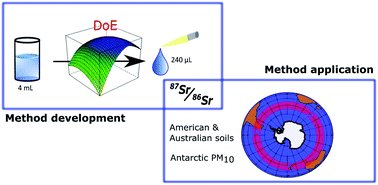Strontium isotopic analysis of environmental microsamples by inductively coupled plasma – tandem mass spectrometry†
Abstract
In this work, a new method has been developed for accurate and precise Sr isotopic analysis of microsamples via inductively coupled plasma – tandem mass spectrometry (ICP-MS/MS). For introduction of low-volume samples, a setup consisting of a syringe-driven pump that allows to work at low and stable sample introduction flow rates was combined with a high-efficiency sample introduction system, originally designed for the introduction of single cells and other discrete entities into the ICP. The method requires 240 μL of sample only, introduced at a sample uptake rate of 20 μL min−1 and allows for the straightforward measurement of the 87Sr/86Sr isotope ratio without prior Rb/Sr separation. The isobaric overlap of the signals of 87Rb and 87Sr is overcome by the selective reaction between Sr+ and CH3F gas in the collision/reaction cell (CRC) of an ICP-MS/MS instrument. In this way, Sr+ ions are measured as their corresponding SrF+ reaction product ions in a mass-shift approach. A multivariate approach was applied to obtain optimum instrument settings (sample uptake rate, nebulizer gas flow rate, make-up gas flow rate, and plasma sampling depth) for maximum sensitivity and optimum precision of the 87Sr/86Sr and 88Sr/86Sr isotope ratios. The method thus developed was found to be accurate (mean bias = −0.001 ± 0.070%, with respect to a quality control reference value) and showed an external precision of 0.17% (RSD, n = 24) at an analytical concentration of 2 ng g−1. The method was applied to the analysis of small-volume digests of samples of Antarctic atmospheric particulates (PM10) and of soils from Australia and South America as potential source areas for atmospheric particulates reaching East Antarctica. The raw soil samples were handled using a dedicated resuspension/collection system to select the finest fraction (PM2.5), thus simulating the long-range transport of mineral dust in the atmosphere. The results obtained for these samples were found to be in good agreement with literature data, demonstrating the suitability of the procedure developed for the Sr isotopic analysis of such complex matrices with Sr concentrations as low as a few ng g−1 (<3 ng g−1 and <7 ng g−1, for the PM10 and soil samples, respectively). The method could also be useful for other environmental samples for which the low Sr concentrations and limited sample amounts are critical aspects.

- This article is part of the themed collection: Community Leaders: Ramon Barnes


 Please wait while we load your content...
Please wait while we load your content...